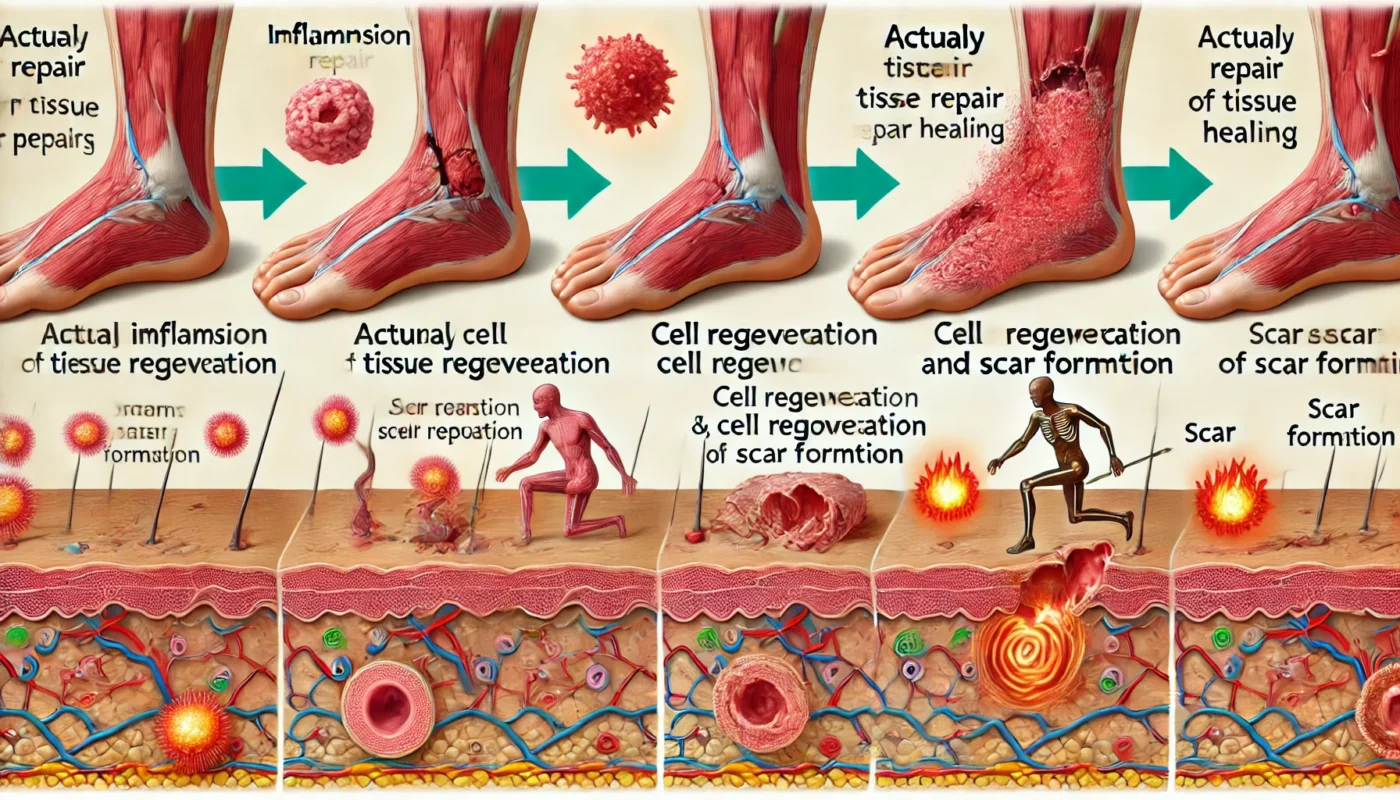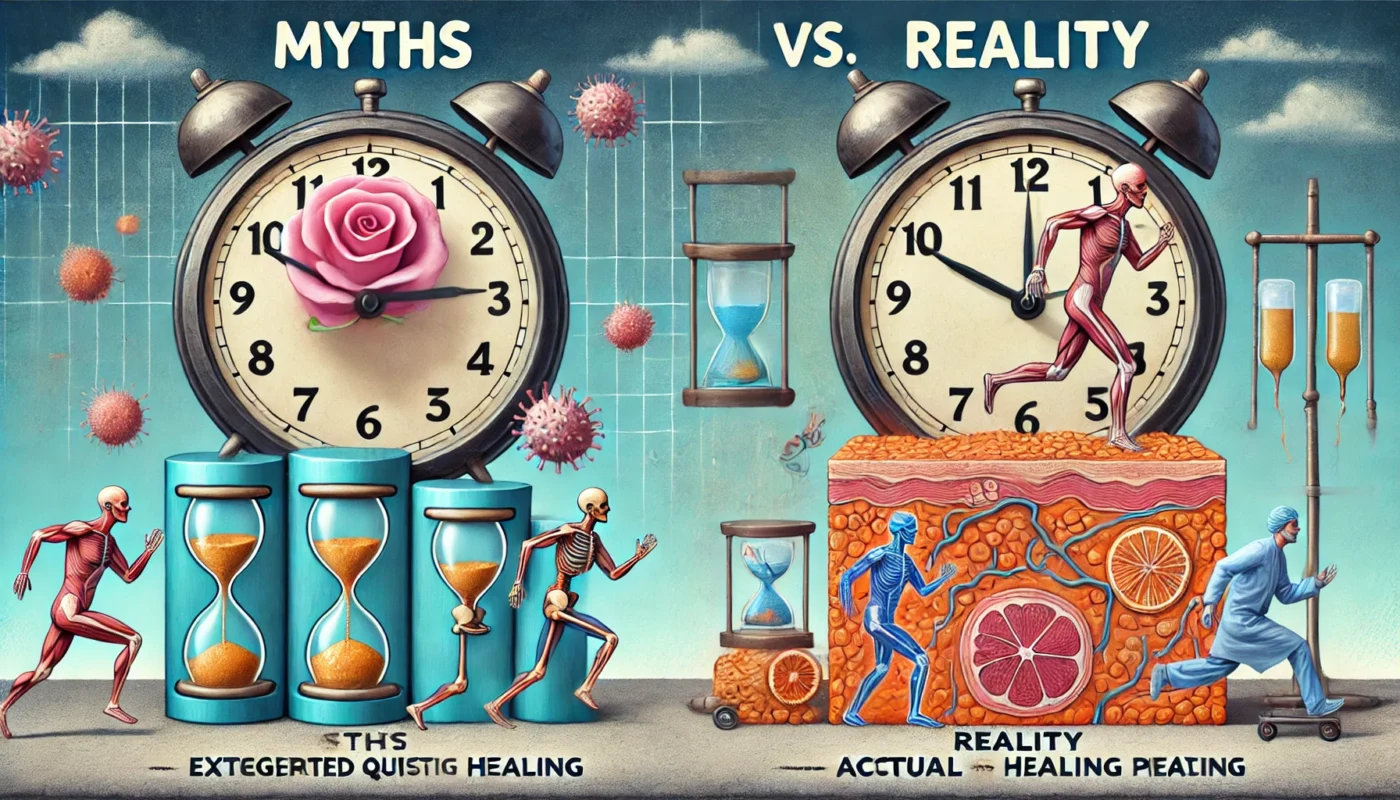In the realm of health and wellness, understanding tissue healing times is crucial for anyone looking to optimize their recovery and well-being. However, myths and misconceptions often cloud this topic, leading to misunderstandings about how the healing process truly works.
For fitness enthusiasts and health-conscious individuals, debunking these myths can provide valuable insights into efficient recovery strategies. This article delves into prevalent myths about tissue healing times, supported by scientific insights and practical advice, to empower you in your wellness journey.
You may also like: Key Factors in Proliferative Wound Healing
Myth 1: All Tissues Heal at the Same Rate
One of the most pervasive myths is the belief that all tissues within the body heal at the same rate. In reality, the healing process varies significantly depending on the type of tissue and the extent of the injury. For instance, skin tissues may heal relatively quickly, while tendons and ligaments can take much longer.
Understanding Tissue Types
The human body comprises various tissues, each with distinct healing timelines:
- Epithelial Tissue: This includes skin and mucous membranes. Generally, epithelial tissues have a high regenerative capacity, allowing for faster healing. The rapid turnover of skin cells facilitates quick repair and regeneration, making minor cuts and abrasions heal swiftly.
- Muscle Tissue: Muscle injuries might heal within weeks to months, contingent on the severity and intervention strategies. Microtears in muscle fibers from exercise-induced stress can heal relatively quickly, but more severe tears require careful rehabilitation to restore full function.
- Tendons and Ligaments: These connective tissues often require a longer time for complete recovery, sometimes extending up to a year, due to limited blood supply. The avascular nature of these tissues slows down nutrient delivery, necessitating prolonged healing periods and specialized care.
- Nervous Tissue: Nervous tissue has a very limited regenerative capacity, and damage is often permanent unless supported by advanced medical interventions. The complex structure of neurons and their slow regeneration rate pose significant challenges in nerve injury recovery.
Factors Influencing Healing Rates
Several factors influence the healing rates of different tissues:
- Blood Supply: Tissues with rich blood supply, like muscles, tend to heal faster due to efficient nutrient and oxygen delivery. Conversely, tissues with poor vascularization, such as tendons and cartilage, experience slower recovery.
- Cellular Regeneration Capacity: Tissues with high cellular turnover, such as epithelial tissues, regenerate more quickly. In contrast, tissues with limited regenerative abilities, like nervous tissue, face prolonged healing challenges.
- Extent of Injury: The severity and nature of the injury significantly impact healing times. Minor injuries may resolve quickly, while extensive damage demands longer recovery periods and comprehensive rehabilitation efforts.
Myth 2: Rest Is the Only Remedy for Healing
Many believe that rest alone is sufficient for tissue healing. While rest is undeniably a critical component, it’s not the sole factor in ensuring effective recovery. Active recovery, including targeted exercises and therapies, can significantly enhance the healing process.
The Role of Active Recovery
Incorporating movement and physical therapy can promote circulation, reduce stiffness, and prevent atrophy:
- Physical Therapy: Structured rehabilitation programs involving controlled movements facilitate optimal healing. Physical therapists design exercises to rebuild strength, improve flexibility, and enhance overall functionality.
- Stretching and Flexibility Exercises: Stretching exercises help maintain joint mobility and prevent stiffness. Regular stretching can improve flexibility in tendons and ligaments, aiding in faster recovery.
- Cardiovascular Exercises: Low-impact cardiovascular exercises, such as walking or swimming, can promote circulation and accelerate healing without overstraining the injured area.
Complementary Therapies
Complementary therapies can play a vital role in supporting tissue healing:
- Massage Therapy: Massage techniques enhance blood flow, reduce muscle tension, and alleviate pain. Regular massages can aid in breaking down scar tissue and improving tissue flexibility.
- Acupuncture: Acupuncture stimulates specific points in the body to promote healing. It can enhance circulation, reduce inflammation, and support the body’s natural recovery mechanisms.
- Chiropractic Care: Chiropractic adjustments can realign the body, relieving pressure on nerves and supporting overall musculoskeletal health. Proper alignment can enhance recovery and prevent further injuries.
The Importance of Balanced Rest
While active recovery is essential, balanced rest remains crucial:
- Sleep and Recovery: Quality sleep is vital for the body’s repair processes. Adequate rest allows for cellular regeneration, hormone regulation, and overall healing.
- Mindful Rest Practices: Incorporating relaxation techniques such as meditation and deep breathing can reduce stress and promote a healing environment. Mindful rest supports mental and physical well-being, facilitating comprehensive recovery.

Myth 3: Speedy Recovery Equals Complete Healing
A rapid return to activity is often mistaken for complete healing. However, the absence of pain does not equate to full recovery. Residual weakness or instability in the tissue can lead to recurrent injuries if not addressed properly.
Monitoring Healing Progress
It is crucial to assess the healing progress through regular check-ups and possibly imaging techniques:
- Regular Check-ups: Routine assessments by healthcare professionals help track healing progress. Regular check-ups provide insights into tissue recovery and guide adjustments in recovery strategies.
- Imaging Techniques: Advanced imaging methods, such as MRI or ultrasound, offer detailed views of tissue healing. These techniques help identify underlying issues, ensuring comprehensive recovery.
- Functional Assessments: Functional tests evaluate the strength, flexibility, and stability of the injured area. These assessments help determine readiness for full activity resumption and highlight areas needing further attention.
Addressing Residual Issues
Unresolved issues can impede complete healing:
- Strengthening Weak Areas: Targeted exercises focus on strengthening weak or compromised areas. Building strength helps restore function and prevent future injuries.
- Stability and Balance Training: Stability exercises enhance proprioception and balance. These activities improve coordination and reduce the risk of re-injury during physical activities.
- Gradual Return to Activity: A gradual approach to resuming activities prevents overexertion. Incremental increases in activity levels allow tissues to adapt and strengthen, minimizing injury risks.
Nutritional Support for Healing
Nutrition plays a crucial role in tissue recovery:
- Anti-inflammatory Diet: A diet rich in anti-inflammatory foods supports healing. Foods like leafy greens, fatty fish, and berries reduce inflammation, promoting optimal recovery.
- Essential Nutrients: Nutrients such as vitamins C and E, zinc, and omega-3 fatty acids aid tissue repair. These nutrients support collagen synthesis, reduce oxidative stress, and enhance the body’s healing capacity.
- Hydration and Recovery: Staying hydrated is vital for cellular function and tissue repair. Adequate fluid intake ensures efficient nutrient delivery and waste removal, supporting overall recovery.
Myth 4: Age Does Not Affect Healing
The notion that age does not influence healing times is another misconception. As we age, the body’s regenerative capabilities diminish, leading to prolonged recovery periods.
Age-Related Healing Considerations
Older adults may experience slower cell proliferation and reduced elasticity in tissues, necessitating more comprehensive recovery plans:
- Slower Cell Turnover: Aging slows down cellular regeneration, extending healing times. Older adults may require extended recovery periods and specialized care to address these changes.
- Reduced Tissue Elasticity: The loss of tissue elasticity affects flexibility and resilience. Maintaining elasticity through targeted exercises and therapies is crucial for effective recovery.
- Increased Comorbidity Risks: Older individuals may face additional health challenges that impact healing. Managing comorbidities through comprehensive healthcare approaches supports overall recovery.
Enhancing Recovery in Older Adults
Strategies to improve healing outcomes in older adults:
- Regular Physical Activity: Consistent exercise maintains muscle mass, bone density, and joint flexibility. Physical activity supports circulation and enhances the body’s healing capabilities.
- Adequate Hydration: Staying hydrated is essential for cellular health and overall recovery. Older adults should prioritize fluid intake to support efficient tissue repair.
- Nutrient-Rich Diet: A diet rich in essential nutrients supports healing and overall health. Nutrient-dense foods provide the building blocks for tissue repair and regeneration.
The Role of Lifestyle Interventions
Lifestyle changes can positively impact healing outcomes:
- Stress Management: Stress reduction techniques enhance healing by promoting a balanced hormonal environment. Practices like yoga, meditation, and mindfulness reduce stress and support recovery.
- Quality Sleep: Prioritizing quality sleep is crucial for tissue repair and overall well-being. Establishing a consistent sleep routine supports the body’s natural recovery processes.
- Social Support: A strong social network provides emotional support and motivation. Engaging in social activities and maintaining connections positively influence mental and physical health.

Myth 5: Supplements are a Magic Bullet
While supplements can support the healing process, they are not a cure-all solution. Relying solely on supplements without addressing other lifestyle factors such as diet, exercise, and stress management may lead to suboptimal recovery outcomes.
Integrating Supplements Wisely
Supplements like collagen, glucosamine, and chondroitin may aid in joint and tissue repair, but they should be used in conjunction with a holistic health strategy:
- Collagen Supplements: Collagen supports skin, joint, and connective tissue health. Supplementing with collagen can aid in tissue repair and improve skin elasticity.
- Glucosamine and Chondroitin: These supplements support joint health and reduce inflammation. They may enhance cartilage repair and alleviate joint pain in certain individuals.
- Omega-3 Fatty Acids: Omega-3s reduce inflammation and support overall health. Supplementing with omega-3s can aid in tissue repair and promote cardiovascular health.
Consulting Healthcare Providers
Professional guidance ensures safe and effective supplement use:
- Individualized Recommendations: Healthcare providers tailor supplement plans to individual needs. Personalized recommendations ensure optimal benefits and minimize potential risks.
- Monitoring Interactions: Healthcare professionals monitor potential interactions with medications. Regular check-ups ensure safe supplement use and prevent adverse effects.
- Evaluating Efficacy: Assessing supplement efficacy guides adjustments in usage. Regular evaluations help determine the effectiveness of supplements in supporting recovery.
The Importance of a Holistic Approach
A comprehensive approach to recovery encompasses more than just supplements:
- Balanced Diet: A nutrient-rich diet provides essential building blocks for healing. Whole foods supply vitamins, minerals, and antioxidants necessary for tissue repair.
- Regular Exercise: Physical activity supports circulation, flexibility, and strength. Exercise complements supplementation by promoting overall health and enhancing recovery.
- Stress Reduction: Managing stress improves hormonal balance and supports healing. Stress-reduction techniques create a conducive environment for recovery and well-being.
Practical Strategies for Optimal Healing
To optimize the healing process, consider the following strategies:
Personalized Recovery Plans
Work with healthcare professionals to create tailored recovery plans based on the specific tissue type and injury severity:
- Individual Assessments: Comprehensive assessments guide personalized recovery strategies. Evaluating injury specifics helps design effective rehabilitation programs.
- Customized Interventions: Tailored interventions address unique needs and challenges. Personalized approaches maximize recovery potential and minimize complications.
- Collaborative Care: A multidisciplinary approach enhances recovery outcomes. Collaboration among healthcare providers ensures comprehensive and coordinated care.
Holistic Approaches
Integrate holistic methods such as yoga, meditation, and mindfulness to reduce stress and promote overall well-being, which indirectly supports healing:
- Mind-Body Practices: Techniques like yoga and tai chi enhance physical and mental well-being. These practices promote relaxation, flexibility, and balance, supporting recovery.
- Mindfulness Techniques: Mindfulness reduces stress and enhances mental clarity. Practicing mindfulness fosters a positive healing environment and improves overall health.
- Complementary Therapies: Integrating therapies like acupuncture and massage enhances recovery. Complementary approaches support holistic healing and overall wellness.
Regular Monitoring
Keep track of healing progress through regular assessments and adjust recovery strategies as needed:
- Progress Evaluations: Regular evaluations track healing milestones and identify challenges. Ongoing assessments guide adjustments in recovery plans for optimal outcomes.
- Feedback and Adjustments: Feedback from healthcare providers informs necessary changes. Adjusting strategies based on progress ensures continued improvement and recovery.
- Preventive Measures: Monitoring helps identify potential issues before they escalate. Early detection and intervention prevent complications and support effective healing.
Balanced Nutrition
Focus on a diet rich in whole foods, antioxidants, and anti-inflammatory components to support tissue regeneration and repair:
- Nutrient-Dense Foods: Consuming a variety of nutrient-rich foods provides essential vitamins and minerals. Whole foods support healing by supplying the necessary nutrients for tissue repair.
- Antioxidant-Rich Diet: Antioxidants combat oxidative stress and support healing. Foods like berries, nuts, and green tea provide powerful antioxidants for cellular protection.
- Anti-Inflammatory Foods: Incorporating anti-inflammatory foods reduces inflammation and promotes healing. Foods like turmeric, ginger, and olive oil aid in reducing inflammatory responses.
Informed Use of Supplements
Use supplements as an adjunct to, not a replacement for, a balanced diet and healthy lifestyle:
- Supplement Synergy: Combining supplements with a balanced diet enhances their effectiveness. Synergistic effects between nutrients and supplements optimize healing outcomes.
- Targeted Supplementation: Tailoring supplements to specific needs enhances recovery. Individualized supplementation addresses unique health challenges and supports overall well-being.
- Lifestyle Integration: Integrating supplements into a holistic lifestyle maximizes benefits. A comprehensive approach combines dietary, exercise, and stress-reduction strategies for optimal recovery.

Conclusion
Dispelling the myths about tissue healing times paves the way for more informed and effective recovery strategies. By understanding the complexities of the healing process and embracing a comprehensive approach, you can enhance your recovery outcomes and maintain optimal health and wellness.
Ultimately, knowledge is power. Armed with the right information and strategies, you can navigate the healing journey with confidence, ensuring that your body recovers efficiently and completely. Empower yourself with scientific insights and practical advice, and take charge of your healing process for a healthier, more resilient you.
Further Reading:
Healing Expectations for Different Tissue Types
supplements, healing process, holistic health, joint health, tissue repair, nutrition, exercise, stress management, personalized recovery, anti-inflammatory foods, antioxidants, healthcare providers, mindfulness, complementary therapies, recovery strategies, wellness
Important Note: The information contained in this article is for general informational purposes only, and should not be construed as health or medical advice, nor is it intended to diagnose, prevent, treat, or cure any disease or health condition. Before embarking on any diet, fitness regimen, or program of nutritional supplementation, it is advisable to consult your healthcare professional in order to determine its safety and probable efficacy in terms of your individual state of health.
Regarding Nutritional Supplements Or Other Non-Prescription Health Products: If any nutritional supplements or other non-prescription health products are mentioned in the foregoing article, any claims or statements made about them have not been evaluated by the U.S. Food and Drug Administration, and such nutritional supplements or other health products are not intended to diagnose, treat, cure, or prevent any disease.

